List of birds of Oman

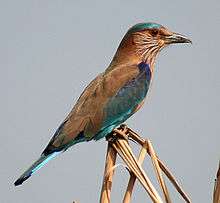
This is a list of the bird species recorded in Oman. The avifauna of Oman include a total of 494 species, of which five have been introduced by humans and 146 are rare or accidental. The ostrich is extirpated in Oman and is not included in the species count. Twelve species are globally threatened.
This list's taxonomic treatment (designation and sequence of orders, families and species) and nomenclature (common and scientific names) generally follow the conventions of The Clements Checklist of Birds of the World, 6th edition with a few changes based on the list of the Ornithological Society of the Middle East. The family accounts at the beginning of each heading reflect the Clements taxonomy, as do the species counts found in each family account. Introduced and accidental species are included in the total counts for Oman.
The following tags have been used to highlight several categories, but not all species fall into one of these categories. Those that do not are commonly occurring native species.
- (A) Accidental - a species that rarely or accidentally occurs in Oman
- (I) Introduced - a species introduced to Oman as a consequence, direct or indirect, of human actions
- (Ex) Extirpated - a species that no longer occurs in Oman although populations exist elsewhere
Ostriches
Order: Struthioniformes Family: Struthionidae
The ostrich is a flightless bird native to Africa. It is the largest living species of bird. It is distinctive in its appearance, with a long neck and legs and the ability to run at high speeds.
- Ostrich, Struthio camelus (Ex)
Grebes
-_breeding_plumage-_in_Hyderabad%2C_AP_W_IMG_7648.jpg)
Order: Podicipediformes Family: Podicipedidae
Grebes are small to medium-large freshwater diving birds. They have lobed toes and are excellent swimmers and divers. However, they have their feet placed far back on the body, making them quite ungainly on land. There are about 19 species worldwide and 3 species which occur in Oman.
- Little grebe, Tachybaptus ruficollis
- Great crested grebe, Podiceps cristatus (A)
- Black-necked grebe, Podiceps nigricollis
Shearwaters and petrels
Order: Procellariiformes Family: Procellariidae
The procellariids are the main group of medium-sized "true petrels", characterised by united nostrils with medium septum and a long outer functional primary.
- Jouanin's petrel, Bulweria fallax
- Streaked shearwater, Calonectris leucomelas (A)
- Scopoli's shearwater, Calonectris diomedea (A)
- Flesh-footed shearwater, Ardenna carneipes
- Wedge-tailed shearwater, Ardenna pacificus
- Sooty shearwater, Ardenna griseus (A)
- Persian shearwater, Puffinus persicus
Storm petrels

Order: Procellariiformes Family: Hydrobatidae
The storm petrels are relatives of the petrels and are the smallest seabirds. They feed on planktonic crustaceans and small fish picked from the surface, typically while hovering. The flight is fluttering and sometimes bat-like. There are about 20 species worldwide and 4 species which occur in Oman.
- Wilson's storm petrel, Oceanites oceanicus
- White-faced storm petrel, Pelagodroma marina (A)
- Black-bellied storm petrel, Fregetta tropica (A)
- Swinhoe's storm petrel, Oceanodroma monorhis
Tropicbirds

Order: Phaethontiformes Family: Phaethontidae
Tropicbirds are slender white birds of tropical oceans, with exceptionally long central tail feathers. Their heads and long wings have black markings.
- Red-billed tropicbird, Phaethon aethereus
Boobies and gannets

Order: Suliformes Family: Sulidae
The sulids comprise the gannets and boobies. Both groups are medium to large coastal seabirds that plunge-dive for fish.
- Cape gannet, Morus capensis (A)
- Masked booby, Sula dactylatra
- Red-footed booby, Sula sula (A)
- Brown booby, Sula leucogaster
Cormorants
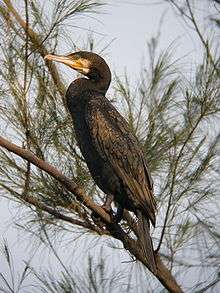
Order: Suliformes Family: Phalacrocoracidae
Phalacrocoracidae is a family of medium to large coastal, fish-eating seabirds that includes cormorants and shags. Plumage colouration varies, with the majority having mainly dark plumage, some species being black-and-white and a few being colourful.
- Great cormorant, Phalacrocorax carbo
- Socotra cormorant, Phalacrocorax nigrogularis
Frigatebirds
Order: Suliformes Family: Fregatidae
Frigatebirds are large seabirds usually found over tropical oceans. They are large, black-and-white or completely black, with long wings and deeply forked tails. The males have coloured inflatable throat pouches. They do not swim or walk and cannot take off from a flat surface. Having the largest wingspan-to-body-weight ratio of any bird, they are essentially aerial, able to stay aloft for more than a week.
- Great frigatebird, Fregata minor (A)
- Lesser frigatebird, Fregata ariel (A)
Pelicans
Order: Pelecaniformes Family: Pelecanidae
Pelicans are large water birds with a distinctive pouch under their beak. As with other members of the order Pelecaniformes, they have webbed feet with four toes.
- Great white pelican, Pelecanus onocrotalus (A)
- Pink-backed pelican, Pelecanus rufescens (A)
- Dalmatian pelican, Pelecanus crispus (A)
Bitterns, herons and egrets
Order: Pelecaniformes Family: Ardeidae
The family Ardeidae contains the bitterns, herons and egrets. Herons and egrets are medium to large wading birds with long necks and legs. Bitterns tend to be shorter necked and more wary. Members of Ardeidae fly with their necks retracted, unlike other long-necked birds such as storks, ibises and spoonbills.
- Grey heron, Ardea cinerea
- Black-headed heron, Ardea melanocephala (A)
- Goliath heron, Ardea goliath (A)
- Purple heron, Ardea purpurea
- Great egret, Ardea alba
- Black heron, Egretta ardesiaca (A)
- Intermediate egret, Egretta intermedia
- Little egret, Egretta garzetta
- Western reef heron, Egretta gularis
- Squacco heron, Ardeola ralloides
- Indian pond-heron, Ardeola grayii
- Cattle egret, Bubulcus ibis
- Striated heron, Butorides striata
- Black-crowned night heron, Nycticorax nycticorax
- Yellow bittern, Ixobrychus sinensis
- Little bittern, Ixobrychus minutus
- Great bittern, Botaurus stellaris
Ibises and spoonbills
Order: Pelecaniformes Family: Threskiornithidae
Threskiornithidae is a family of large terrestrial and wading birds which includes the ibises and spoonbills. They have long, broad wings with 11 primary and about 20 secondary feathers. They are strong fliers and despite their size and weight, very capable soarers.
- Sacred ibis, Threskiornis aethiopicus (A)
- Glossy ibis, Plegadis falcinellus
- Eurasian spoonbill, Platalea leucorodia
- African spoonbill, Platalea alba (A)
Storks
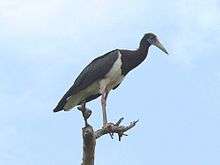
Order: Ciconiiformes Family: Ciconiidae
Storks are large, long-legged, long-necked, wading birds with long, stout bills. Storks are mute, but bill-clattering is an important mode of communication at the nest. Their nests can be large and may be reused for many years. Many species are migratory.
- Black stork, Ciconia nigra (A)
- Abdim's stork, Ciconia abdimii
- White stork, Ciconia ciconia
Flamingos
Order: Phoenicopteriformes Family: Phoenicopteridae
Flamingos are gregarious wading birds, usually 3 to 5 feet (0.9 to 1.5 m) tall, found in both the Western and Eastern Hemispheres. Flamingos filter-feed on shellfish and algae. Their oddly shaped beaks are specially adapted to separate mud and silt from the food they consume and, uniquely, are used upside-down. There are about 6 species worldwide and 2 species which occur in Oman.
- Greater flamingo, Phoenicopterus roseus
- Lesser flamingo, Phoenicopterus minor (A)
Ducks, geese and swans
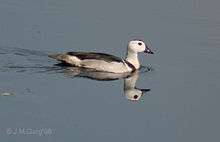
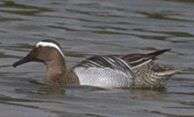
Order: Anseriformes Family: Anatidae
Anatidae includes the ducks and most duck-like waterfowl, such as geese and swans. These birds are adapted to an aquatic existence with webbed feet, flattened bills, and feathers that are excellent at shedding water due to an oily coating.
- Fulvous whistling duck, Dendrocygna bicolor (A)
- Lesser whistling duck, Dendrocygna javanica (A)
- Mute swan, Cygnus olor (A)
- Whooper swan, Cygnus cygnus (A)
- Bewick's swan, Cygnus columbianus (A)
- Greater white-fronted goose, Anser albifrons
- Lesser white-fronted goose, Anser erythropus (A)
- Greylag goose, Anser anser
- Egyptian goose, Alopochen aegyptiacus (A)
- Ruddy shelduck, Tadorna ferruginea
- Common shelduck, Tadorna tadorna
- Comb duck, Sarkidiornis melanotos (A)
- Cotton pygmy goose, Nettapus coromandelianus
- Eurasian wigeon, Anas penelope
- Gadwall, Anas strepera
- Eurasian teal, Anas crecca
- Mallard, Anas platyrhynchos
- Northern pintail, Anas acuta
- Garganey, Anas querquedula
- Northern shoveler, Anas clypeata
- Marbled teal, Marmaronetta angustirostris (A)
- Red-crested pochard, Netta rufina
- Common pochard, Aythya ferina
- Ferruginous duck, Aythya nyroca
- Tufted duck, Aythya fuligula
- Red-breasted merganser, Mergus serrator (A)
Osprey
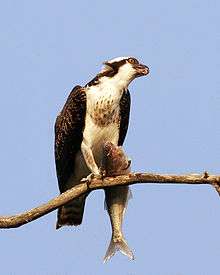
Order: Accipitriformes Family: Pandionidae
The Pandionidae family contains only one species, the osprey. The osprey is a medium-large raptor which is a specialist fish-eater with a worldwide distribution.
- Osprey, Pandion haliaetus
Hawks, kites and eagles


Order: Accipitriformes Family: Accipitridae
Accipitridae is a family of birds of prey, which includes hawks, eagles, kites, harriers and Old World vultures. These birds have powerful hooked beaks for tearing flesh from their prey, strong legs, powerful talons and keen eyesight.
- European honey buzzard, Pernis apivorus
- Crested honey buzzard, Pernis ptilorhynchus (A)
- Black-shouldered kite, Elanus caeruleus (A)
- Black kite, Milvus migrans
- Yellow-billed kite, Milvus aegyptius
- Pallas's fish eagle, Haliaeetus leucoryphus (A)
- Egyptian vulture, Neophron percnopterus
- Eurasian griffon vulture, Gyps fulvus
- Cinereous vulture, Aegypius monachus (A)
- Lappet-faced vulture, Torgos tracheliotos
- Short-toed snake eagle, Circaetus gallicus
- Western marsh harrier, Circus aeruginosus
- Northern harrier, Circus cyaneus
- Pallid harrier, Circus macrourus
- Montagu's harrier, Circus pygargus
- Shikra, Accipiter badius (A)
- Eurasian sparrowhawk, Accipiter nisus
- Northern goshawk, Accipiter gentilis (A)
- White-eyed buzzard, Butastur teesa (A)
- Eurasian buzzard, Buteo buteo
- Long-legged buzzard, Buteo rufinus
- Lesser spotted eagle, Clanga pomarina (A)
- Greater spotted eagle, Clanga clanga
- Tawny eagle, Aquila rapax (A)
- Steppe eagle, Aquila nipalensis
- Eastern imperial eagle, Aquila heliaca
- Golden eagle, Aquila chrysaetos
- Verreaux's eagle, Aquila verreauxii
- Bonelli's eagle, Aquila fasciata
- Booted eagle, Hieraaetus pennatus
Falcons
.jpg)
Order: Falconiformes Family: Falconidae
Falconidae is a family of diurnal birds of prey. They differ from hawks, eagles and kites in that they kill with their beaks instead of their talons. There are about 64 species worldwide and 10 species which occur in Oman.
- Lesser kestrel, Falco naumanni
- Eurasian kestrel, Falco tinnunculus
- Amur falcon, Falco amurensis
- Sooty falcon, Falco concolor
- Merlin, Falco columbarius (A)
- Eurasian hobby, Falco subbuteo
- Lanner falcon, Falco biarmicus
- Saker falcon, Falco cherrug
- Barbary falcon, Falco pelegrinoides
- Peregrine falcon, Falco peregrinus
Partridges and quails
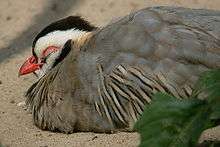
Order: Galliformes Family: Phasianidae
The Phasianidae are a family of terrestrial birds which consists of quails, partridges, snowcocks, francolins, spurfowls, tragopans, monals, pheasants, peafowls and jungle fowls. In general, they are plump (although they vary in size) and have broad, relatively short wings. There are about 155 species worldwide and 6 species which occur in Oman.
- Chukar, Alectoris chukar
- Arabian partridge, Alectoris melanocephala
- Sand partridge, Ammoperdix heyi
- Grey francolin, Francolinus pondicerianus
- Common quail, Coturnix coturnix
- Harlequin quail, Coturnix delegorguei (A)
Cranes
.jpg)
Order: Gruiformes Family: Gruidae
Cranes are large, long-legged and long-necked birds. Unlike the similar-looking but unrelated herons, cranes fly with necks outstretched, not pulled back. Most have elaborate and noisy courting displays or "dances".
- Demoiselle crane, Anthropoides virgo
- Common crane, Grus grus
Rails, crakes, gallinules and coots

Order: Gruiformes Family: Rallidae
Rallidae is a large family of small to medium-sized birds which includes the rails, crakes, coots and gallinules. Typically they inhabit dense vegetation in damp environments near lakes, swamps or rivers. In general they are shy and secretive birds, making them difficult to observe. Most species have strong legs and long toes which are well adapted to soft uneven surfaces. They tend to have short, rounded wings and to be weak fliers.
- Water rail, Rallus aquaticus
- Corn crake, Crex crex
- White-breasted waterhen, Amaurornis phoenicurus
- Little crake, Porzana parva
- Baillon's crake, Porzana pusilla
- Spotted crake, Porzana porzana
- Watercock, Gallicrex cinerea (A)
- Grey-headed swamphen, Porphyrio poliocephalus (A)
- Allen's gallinule, Porphyrio alleni (A)
- Common moorhen, Gallinula chloropus
- Lesser moorhen, Gallinula angulata (A)
- Red-knobbed coot, Fulica cristata (A)
- Eurasian coot, Fulica atra
Bustards
Order: Otidiformes Family: Otididae
Bustards are large terrestrial birds mainly associated with dry open country and steppes in the Old World. They are omnivorous and nest on the ground. They walk steadily on strong legs and big toes, pecking for food as they go. They have long broad wings with "fingered" wingtips and striking patterns in flight. Many have interesting mating displays.
- Macqueen's bustard, Chlamydotis macqueenii
- Little bustard, Tetrax tetrax (A)
Buttonquails
Order: Charadriiformes Family: Turnicidae
The buttonquails are small, drab, running birds which resemble the true quails. The female is the brighter of the sexes and initiates courtship. The male incubates the eggs and tends the young.
- Small buttonquail, Turnix sylvatica (A)
Jacanas
_I_IMG_8638.jpg)
Order: Charadriiformes Family: Jacanidae
The jacanas are a group of tropical waders in the family Jacanidae. They are found throughout the tropics. They are identifiable by their huge feet and claws which enable them to walk on floating vegetation in the shallow lakes that are their preferred habitat. There are 8 species worldwide and 1 species which occurs in Oman.
- Pheasant-tailed jacana, Hydrophasianus chirurgus
Painted-snipe
Order: Charadriiformes Family: Rostratulidae
Painted-snipe are short-legged, long-billed birds similar in shape to the true snipes, but more brightly coloured.
- Greater painted-snipe, Rostratula benghalensis (A)
Crab-plover
Order: Charadriiformes Family: Dromadidae
The crab-plover is related to the waders. It resembles a plover but with very long grey legs and a strong heavy black bill similar to a tern. It has black-and-white plumage, a long neck, partially webbed feet and a bill designed for eating crabs.
- Crab-plover, Dromas ardeola
Oystercatchers

Order: Charadriiformes Family: Haematopodidae
The oystercatchers are large and noisy plover-like birds, with strong bills used for smashing or prising open molluscs. There are about 11 species worldwide and 1 species which occurs in Oman.
- Eurasian oystercatcher, Haematopus ostralegus
Avocets and stilts
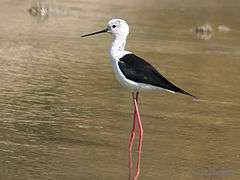
Order: Charadriiformes Family: Recurvirostridae
Recurvirostridae is a family of large wading birds, which includes the avocets and stilts. The avocets have long legs and long up-curved bills. The stilts have extremely long legs and long, thin, straight bills. There are about 9 species worldwide and 2 species which occur in Oman.
- Black-winged stilt, Himantopus himantopus
- Pied avocet, Recurvirostra avosetta
Thick-knees
Order: Charadriiformes Family: Burhinidae
The thick-knees are a group of largely tropical waders in the family Burhinidae. They are found worldwide within the tropical zone, with some species also breeding in temperate Europe and Australia. They are medium to large waders with strong black or yellow-black bills, large yellow eyes and cryptic plumage. Despite being classed as waders, most species have a preference for arid or semi-arid habitats.
- Eurasian stone-curlew, Burhinus oedicnemus
- Spotted thick-knee, Burhinus capensis
- Great thick-knee, Esacus recurvirostris
Pratincoles and coursers
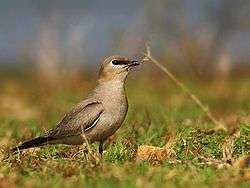
Order: Charadriiformes Family: Glareolidae
Glareolidae is a family of wading birds comprising the pratincoles, which have short legs, long pointed wings and long forked tails, and the coursers, which have long legs, short wings and long, pointed bills which curve downwards. There are 17 species worldwide and 4 species which occur in Oman.
- Cream-coloured courser, Cursorius cursor
- Collared pratincole, Glareola pratincola
- Black-winged pratincole, Glareola nordmanni (A)
- Small pratincole, Glareola lactea
Plovers and lapwings
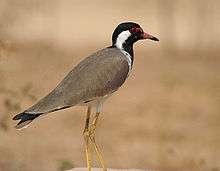
Order: Charadriiformes Family: Charadriidae
The family Charadriidae includes the plovers, dotterels and lapwings. They are small to medium-sized birds with compact bodies, short, thick necks and long, usually pointed, wings. They are found in open country worldwide, mostly in habitats near water. There are about 66 species worldwide and 16 species which occur in Oman.
- Northern lapwing, Vanellus vanellus
- Spur-winged plover, Vanellus spinosus
- Red-wattled lapwing, Vanellus indicus
- Sociable lapwing, Vanellus gregarius
- White-tailed lapwing, Vanellus leucurus
- Pacific golden-plover, Pluvialis fulva
- American golden-plover, Pluvialis dominica (A)
- European golden-plover, Pluvialis apricaria (A)
- Black-bellied plover, Pluvialis squatarola
- Common ringed plover, Charadrius hiaticula
- Little ringed plover, Charadrius dubius
- Kentish plover, Charadrius alexandrinus
- Lesser sandplover, Charadrius mongolus
- Greater sandplover, Charadrius leschenaultii
- Caspian plover, Charadrius asiaticus
- Eurasian dotterel, Charadrius morinellus (A)
Sandpipers and allies

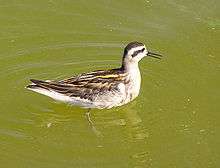
Order: Charadriiformes Family: Scolopacidae
Scolopacidae is a large diverse family of small to medium-sized shorebirds including the sandpipers, curlews, godwits, shanks, tattlers, woodcocks, snipes, dowitchers and phalaropes. The majority of these species eat small invertebrates picked out of the mud or soil. Variation in length of legs and bills enables multiple species to feed in the same habitat, particularly on the coast, without direct competition for food. There are about 89 species worldwide and 39 species which occur in Oman.
- Eurasian woodcock, Scolopax rusticola (A)
- Jack snipe, Lymnocryptes minimus
- Pintail snipe, Gallinago stenura
- Great snipe, Gallinago media
- Common snipe, Gallinago gallinago
- Long-billed dowitcher, Limnodromus scolopaceus (A)
- Black-tailed godwit, Limosa limosa
- Bar-tailed godwit, Limosa lapponica
- Whimbrel, Numenius phaeopus
- Slender-billed curlew, Numenius tenuirostris (A)
- Eurasian curlew, Numenius arquata
- Far Eastern curlew, Numenius madagascariensis (A)
- Terek sandpiper, Xenus cinereus
- Common sandpiper, Actitis hypoleucos
- Green sandpiper, Tringa ochropus
- Spotted redshank, Tringa erythropus
- Common greenshank, Tringa nebularia
- Lesser yellowlegs, Tringa nebularia (A)
- Marsh sandpiper, Tringa stagnatilis
- Wood sandpiper, Tringa glareola
- Common redshank, Tringa totanus
- Ruddy turnstone, Arenaria interpres
- Great knot, Calidris tenuirostris
- Red knot, Calidris canutus (A)
- Sanderling, Calidris alba
- Little stint, Calidris minuta
- Temminck's stint, Calidris temminckii
- Long-toed stint, Calidris subminuta
- Baird's sandpiper, Calidris bairdii (A)
- Pectoral sandpiper, Calidris melanotos (A)
- Sharp-tailed sandpiper, Calidris acuminata (A)
- Curlew sandpiper, Calidris ferruginea
- Dunlin, Calidris alpina
- Broad-billed sandpiper, Limicola falcinellus
- Buff-breasted sandpiper, Tryngites subruficollis (A)
- Ruff, Philomachus pugnax
- Wilson's phalarope, Phalaropus tricolor (A)
- Red-necked phalarope, Phalaropus lobatus
- Red phalarope, Phalaropus fulicarius
Skuas

Order: Charadriiformes Family: Stercorariidae
The family Stercorariidae are, in general, medium to large birds, typically with grey or brown plumage, often with white markings on the wings. They nest on the ground in temperate and arctic regions and are long-distance migrants. There are about 7 species worldwide and 5 species which occur in Oman.
- South polar skua, Stercorarius maccormicki (A)
- Brown skua, Stercorarius antarctica (A)
- Pomarine skua, Stercorarius pomarinus
- Arctic skua, Stercorarius parasiticus
- Long-tailed skua, Stercorarius longicaudus (A)
Gulls

Order: Charadriiformes Family: Laridae
Laridae is a family of medium to large seabirds, the gulls and kittiwakes. They are typically grey or white, often with black markings on the head or wings. They have stout, longish bills and webbed feet.
- White-eyed gull, Ichthyaetus leucophthalmus (A)
- Sooty gull, Ichthyaetus hemprichii
- Pallas's gull, Ichthyaetus ichthyaetus
- Brown-headed gull, Chroicocephalus brunnicephalus (A)
- Black-headed gull, Chroicocephalus ridibundus
- Slender-billed gull, Chroicocephalus genei
- Common gull, Larus canus
- Lesser black-backed gull, Larus fuscus
- Heuglin's gull, Larus heuglini
- Caspian gull, Larus cachinnans
- Black-legged kittiwake, Rissa tridactyla (A)
Terns
Order: Charadriiformes Family: Sternidae
Terns are a group of generally medium to large seabirds typically with grey or white plumage, often with black markings on the head. Most terns hunt fish by diving but some pick insects off the surface of fresh water. Terns are generally long-lived birds, with several species known to live in excess of 30 years. There are about 44 species worldwide and 18 species which occur in Oman.
- Brown noddy, Anous stolidus
- Lesser noddy, Anous tenuirostris
- Sooty tern, Onychoprion fuscatus
- Bridled tern, Onychoprion anaethetus
- Little tern, Sternula albifrons
- Saunders's tern, Sternula saundersi
- Gull-billed tern, Gelochelidon nilotica
- Caspian tern, Hydroprogne caspia
- Black tern, Chlidonias niger (A)
- White-winged tern, Chlidonias leucopterus
- Whiskered tern, Chlidonias hybridus
- Roseate tern, Sterna dougallii
- Arctic tern, Sterna paradisaea (A)
- Common tern, Sterna hirundo
- White-cheeked tern, Sterna repressa
- Great crested tern, Thalasseus bergii
- Sandwich tern, Thalasseus sandvicensis
- Lesser crested tern, Thalasseus bengalensis
Skimmers
Order: Charadriiformes Family: Rynchopidae
Skimmers are a small family of tropical tern-like birds. They have an elongated lower mandible which they use to feed by flying low over the water surface and skimming the water for small fish. There are 3 species worldwide and 1 species which occurs in Oman.
- Indian skimmer, Rynchops albicollis (A)
Sandgrouse
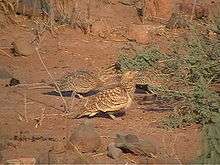
Order: Pterocliformes Family: Pteroclidae
Sandgrouse have small, pigeon like heads and necks, but sturdy compact bodies. They have long pointed wings and sometimes tails and a fast direct flight. Flocks fly to watering holes at dawn and dusk. Their legs are feathered down to the toes. There are 16 species worldwide and 5 species which occur in Oman.
- Pin-tailed sandgrouse, Pterocles alchata (A)
- Chestnut-bellied sandgrouse, Pterocles exustus
- Spotted sandgrouse, Pterocles senegallus
- Crowned sandgrouse, Pterocles coronatus
- Lichtenstein's sandgrouse, Pterocles lichtensteinii
Pigeons and doves
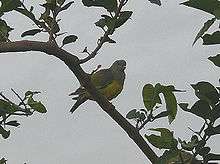
Order: Columbiformes Family: Columbidae
Pigeons and doves are stout-bodied birds with short necks and short slender bills with a fleshy cere.
- Rock dove, Columba livia
- Stock dove, Columba oenas (A)
- Common wood pigeon, Columba palumbus
- European turtle dove, Streptopelia turtur
- Oriental turtle dove, Streptopelia orientalis
- Eurasian collared dove, Streptopelia decaocto
- African collared dove, Streptopelia roseogrisea (A)
- Red collared-dove, Streptopelia tranquebarica (A)
- Laughing dove, Spilopelia senegalensis
- Namaqua dove, Oena capensis
- Bruce's green pigeon, Treron waalia
Parrots
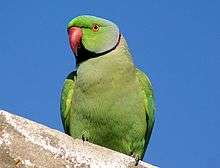
Order: Psittaciformes Family: Psittaculidae
- Rose-ringed parakeet, Psittacula krameri (I)
Cuckoos

Order: Cuculiformes Family: Cuculidae
The family Cuculidae includes cuckoos, roadrunners and anis. These birds are of variable size with slender bodies, long tails and strong legs. The Old World cuckoos are brood parasites. There are about 141 species worldwide and 7 species which occur in Oman.
- Pied cuckoo, Clamator jacobinus
- Great spotted cuckoo, Clamator glandarius
- Common hawk-cuckoo, Cuculus varius (A)
- Common cuckoo, Cuculus canorus
- Plaintive cuckoo, Cacomantis merulinus (A)
- Dideric cuckoo, Chrysococcyx caprius
- Asian koel, Eudynamys scolopacea
Barn owls
Order: Strigiformes Family: Tytonidae
Barn owls are medium to large owls with large heads and characteristic heart-shaped faces. They have long strong legs with powerful talons. There are about 16 species worldwide and 1 species which occurs in Oman.
- Barn owl, Tyto alba
Typical owls
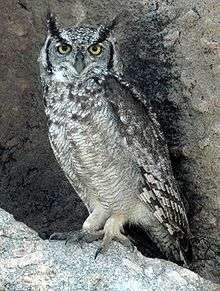
Order: Strigiformes Family: Strigidae
The typical owls are small to large solitary nocturnal birds of prey. They have large forward-facing eyes and ears, a hawk-like beak and a conspicuous circle of feathers around each eye called a facial disk. There are about 200 species worldwide and 10 species which occur in Oman.
- Pallid scops owl, Otus brucei
- Arabian scops owl, Otus pamelae
- European scops owl, Otus scops
- Pharaoh eagle-owl, Bubo ascalaphus
- Spotted eagle-owl, Bubo africanus
- Omani owl, Strix butleri
- Little owl, Athene noctua
- Long-eared owl, Asio otus (A)
- Short-eared owl, Asio flammeus
- Desert owl, Strix hadorami
Nightjars

Order: Caprimulgiformes Family: Caprimulgidae
Nightjars are medium-sized nocturnal birds that usually nest on the ground. They have long wings, short legs and very short bills. Most have small feet, of little use for walking, and long pointed wings. Their soft plumage is camouflaged to resemble bark or leaves. There are about 91 species worldwide and 3 species which occur in Oman.
- European nightjar, Caprimulgus europaeus
- Egyptian nightjar, Caprimulgus aegyptius
- Nubian nightjar, Caprimulgus nubicus (A)
Swifts
Order: Apodiformes Family: Apodidae
Swifts are small birds which spend the majority of their lives flying. These birds have very short legs and never settle voluntarily on the ground, perching instead only on vertical surfaces. Many swifts have long swept-back wings which resemble a crescent or boomerang. There are about 100 species worldwide and 4 species which occur in Oman.
- Alpine swift, Tachymarptis melba
- Common swift, Apus apus
- Pallid swift, Apus pallidus
- Little swift, Apus affinis
Kingfishers

Order: Coraciiformes Family: Alcedinidae
Kingfishers are medium-sized birds with large heads, long, pointed bills, short legs and stubby tails. There are about 93 species worldwide and 5 species which occur in Oman.
- Common kingfisher, Alcedo atthis
- Malachite kingfisher, Alcedo cristata (A)
- Grey-headed kingfisher, Halcyon leucocephala
- Collared kingfisher, Todirhamphus chloris
- Pied kingfisher, Ceryle rudis (A)
Bee-eaters
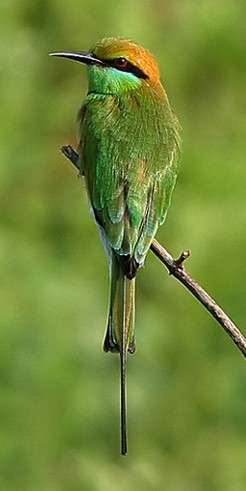
Order: Coraciiformes Family: Meropidae
The bee-eaters are a group of near passerine birds in the family Meropidae. Most species are found in Africa but others occur in southern Europe, Madagascar, Australia and New Guinea. They are characterised by richly coloured plumage, slender bodies and usually elongated central tail feathers. All are colourful and have long downturned bills and pointed wings, which give them a swallow-like appearance when seen from afar. There are about 26 species worldwide and 4 species which occur in Oman.
- White-throated bee-eater, Merops albicollis (A)
- Green bee-eater, Merops orientalis
- Blue-cheeked bee-eater, Merops persicus
- European bee-eater, Merops apiaster
Typical rollers
Order: Coraciiformes Family: Coraciidae
Rollers resemble crows in size and build, but are more closely related to the kingfishers and bee-eaters. They share the colourful appearance of those groups with blues and browns predominating. The two inner front toes are connected, but the outer toe is not. There are about 12 species worldwide and 3 species which occur in Oman.
- European roller, Coracias garrulus
- Lilac-breasted roller, Coracias caudata (A)
- Indian roller, Coracias benghalensis
Hoopoes
_at_Hodal_I_IMG_9216.jpg)
Order: Coraciiformes Family: Upupidae
Hoopoes have black, white and orangey-pink colouring with a large erectile crest on their head. There are about 2 species worldwide and 1 species which occurs in Oman.
- Eurasian hoopoe, Upupa epops
Woodpeckers and allies
Order: Piciformes Family: Picidae
Woodpeckers are small to medium-sized birds with chisel-like beaks, short legs, stiff tails and long tongues used for capturing insects. Some species have feet with two toes pointing forward and two backward, while several species have only three toes. Many woodpeckers have the habit of tapping noisily on tree trunks with their beaks.
- Eurasian wryneck, Jynx torquilla
Larks
_at_Sultanpur_I_Picture_118.jpg)
Order: Passeriformes Family: Alaudidae
Larks are small terrestrial birds with often extravagant songs and display flights. Most larks are fairly dull in appearance. Their food is insects and seeds.
- Singing bushlark, Mirafra cantillans
- Black-crowned sparrow-lark, Eremopterix nigriceps
- Bar-tailed lark, Ammomanes cincturus
- Desert lark, Ammomanes deserti
- Greater hoopoe-lark, Alaemon alaudipes
- Thick-billed lark, Ramphocoris clotbey (A)
- Bimaculated lark, Melanocorypha bimaculata
- Greater short-toed lark, Calandrella brachydactyla
- Blanford's lark, Calandrella blanfordi (A)
- Lesser short-toed lark, Alaudala rufescens
- Dunn's lark, Eremalauda dunni
- Crested lark, Galerida cristata
- Eurasian skylark, Alauda arvensis
- Oriental skylark, Alauda gulgula
Swallows and martins

Order: Passeriformes Family: Hirundinidae
The family Hirundinidae is adapted to aerial feeding. They have a slender streamlined body, long pointed wings and a short bill with a wide gape. The feet are adapted to perching rather than walking, and the front toes are partially joined at the base. There are about 83 species worldwide and 11 species which occur in Oman.
- Sand martin, Riparia riparia
- Pale martin, Riparia diluta (A)
- Grey-throated martin, Riparia chinensis
- Pale crag martin, Ptyonoprogne obsoleta
- Barn swallow, Hirundo rustica
- Wire-tailed swallow, Hirundo smithii (A)
- Lesser striped swallow, Cecropis abyssinica (A)
- Red-rumped swallow, Cecropis daurica
- Streak-throated swallow, Petrochelidon fluvicola (A)
- Common house martin, Delichon urbicum
Wagtails and pipits
_Im_IMG_9617.jpg)
Order: Passeriformes Family: Motacillidae
Motacillidae is a family of small passerine birds with medium to long tails. They include the wagtails, longclaws and pipits. They are slender, ground feeding insectivores of open country. There are about 66 species worldwide and 16 species which occur in Oman.
- Richard's pipit, Anthus richardi
- Long-billed pipit, Anthus similis
- Blyth's pipit, Anthus godlewskii (A)
- Tawny pipit, Anthus campestris
- Meadow pipit, Anthus pratensis (A)
- Red-throated pipit, Anthus cervinus
- Olive-backed pipit, Anthus hodgsoni
- Tree pipit, Anthus trivialis
- Water pipit, Anthus spinoletta
- Buff-bellied pipit, Anthus rubescens (A)
- Golden pipit, Tmetothylacus tenellus (A)
- Forest wagtail, Dendronanthus indicus (A)
- White wagtail, Motacilla alba
- Yellow wagtail, Motacilla flava
- Citrine wagtail, Motacilla citreola
- Grey wagtail, Motacilla cinerea
Bulbuls
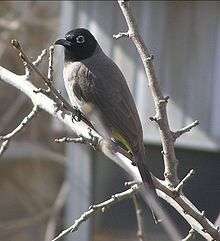
Order: Passeriformes Family: Pycnonotidae
Bulbuls are medium-sized songbirds. Some are colourful with yellow, red or orange vents, cheeks, throats or supercilia, but most are drab, with uniform olive-brown to black plumage. Some species have distinct crests. There are about 130 species worldwide and 3 species which occur in Oman.
- White-spectacled bulbul, Pycnonotus xanthopygos
- White-eared bulbul, Pycnonotus leucotis
- Red-vented bulbul, Pycnonotus cafer (I)
Grey hypocolius

Order: Passeriformes Family: Hypocoliidae
The grey hypocolius is a small Middle Eastern bird with the shape and soft plumage of a waxwing. They are mainly a uniform grey colour except the males have a black triangular mask around their eyes.
- Hypocolius, Hypocolius ampelinus
Accentors
Order: Passeriformes Family: Prunellidae
The accentors are in the only bird family, Prunellidae, which is completely endemic to the Palearctic. They are small, fairly drab species superficially similar to sparrows. There are 13 species worldwide and 2 species which occur in Oman.
- Radde's accentor, Prunella ocularis (A)
- Black-throated accentor, Prunella atrogularis (A)
Thrushes
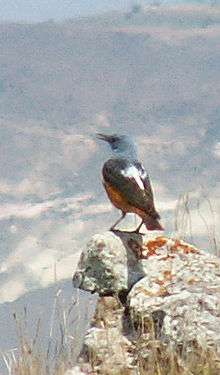
Order: Passeriformes Family: Turdidae
The thrushes are a group of passerine birds that occur mainly in the Old World. They are plump, soft plumaged, small to medium-sized insectivores or sometimes omnivores, often feeding on the ground. Many have attractive songs.
- Scaly thrush, Zoothera dauma (A)
- Ring ouzel, Turdus torquatus (A)
- Eyebrowed thrush, Turdus obscurus (A)
- Dark-throated thrush, Turdus ruficollis
- Dusky thrush, Turdus naumanni (A)
- Song thrush, Turdus philomelos
- Mistle thrush, Turdus viscivorus (A)
Cisticolas and allies
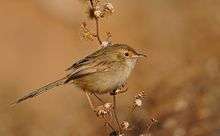
Order: Passeriformes Family: Cisticolidae
The Cisticolidae are warblers found mainly in warmer southern regions of the Old World. They are generally very small birds of drab brown or grey appearance found in open country such as grassland or scrub.
- Zitting cisticola, Cisticola juncidis (A)
- Graceful prinia, Prinia gracilis
Streaked scrub warbler
Order: Passeriformes Family: Scotocercidae
- Streaked scrub warbler, Scotocerca inquieta
Locustellid warblers
Order: Passeriformes Family: Locustellidae
- Common grasshopper warbler, Locustella naevia
- Eurasian river warbler, Locustella fluviatilis (A)
- Savi's warbler, Locustella luscinioides (A)
Acrocephalid warblers
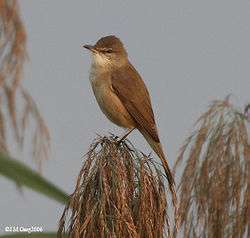
Order: Passeriformes Family: Acrocephalidae
- Moustached warbler, Acrocephalus melanopogon (A)
- Sedge warbler, Acrocephalus schoenobaenus
- Paddyfield warbler, Acrocephalus agricola (A)
- Eurasian reed warbler, Acrocephalus scirpaceus
- Blyth's reed warbler, Acrocephalus dumetorum (A)
- Marsh warbler, Acrocephalus palustris
- Great reed-warbler, Acrocephalus arundinaceus
- Clamorous reed warbler, Acrocephalus stentoreus
- Thick-billed warbler, Iduna aedon (A)
- Booted warbler, Iduna caligata
- Sykes's warbler, Iduna rama
- Eastern olivaceous warbler, Iduna pallida
- Upcher's warbler, Hippolais languida
- Olive-tree warbler, Hippolais olivetorum (A)
- Icterine warbler, Hippolais icterina (A)
Phylloscopid warblers

Order: Passeriformes Family: Phylloscopidae
- Willow warbler, Phylloscopus trochilus
- Common chiffchaff, Phylloscopus collybita
- Plain leaf warbler, Phylloscopus neglectus
- Eastern Bonelli's warbler, Phylloscopus orientalis (A)
- Wood warbler, Phylloscopus sibilatrix
- Yellow-browed warbler, Phylloscopus inornatus (A)
- Hume's warbler, Phylloscopus humei (A)
- Arctic warbler, Phylloscopus borealis (A)
- Greenish warbler, Phylloscopus trochiloides (A)
- Green warbler, Phylloscopus nitidus
Old World warblers
Order: Passeriformes Family: Sylviidae
The family Sylviidae is a group of small insectivorous passerine birds. They mainly occur as breeding species, as the common name implies, in Europe, Asia and, to a lesser extent, Africa. Most are of generally undistinguished appearance, but many have distinctive songs.
- Eurasian blackcap, Sylvia atricapilla
- Garden warbler, Sylvia borin
- Greater whitethroat, Sylvia communis
- Lesser whitethroat, Sylvia curruca
- Small whitethroat, Sylvia minula
- Hume's whitethroat, Sylvia althaea (A)
- Asian desert warbler, Sylvia nana
- Barred warbler, Sylvia nisoria
- Eastern Orphean warbler, Sylvia crassirostris
- Arabian warbler, Sylvia leucomelaena
- Menetries's warbler, Sylvia mystacea
- Sardinian warbler, Sylvia melanocephala (A)
Old World flycatchers and chats
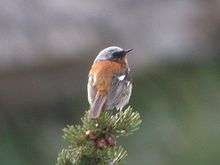
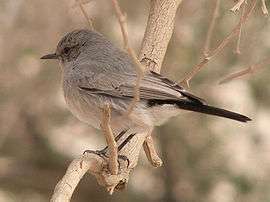
Order: Passeriformes Family: Muscicapidae
Old World flycatchers are a large group of small passerine birds native to the Old World. They are mainly small arboreal insectivores. The appearance of these birds is highly varied, but they mostly have weak songs and harsh calls.
- Common rock thrush, Monticola saxatilis
- Blue rock thrush, Monticola solitarius
- Spotted flycatcher, Muscicapa striata
- Asian brown flycatcher, Muscicapa dauurica (A)
- European pied flycatcher, Ficedula hypoleuca (A)
- Semicollared flycatcher, Ficedula semitorquata
- Red-breasted flycatcher, Ficedula parva
- Blue-and-white flycatcher, Cyanoptila cyanomelana (A)
- European robin, Erithacus rubecula (A)
- Thrush nightingale, Luscinia luscinia (A)
- Common nightingale, Luscinia megarhynchos
- Bluethroat, Luscinia svecica
- White-throated robin, Irania gutturalis
- Rufous-tailed scrub-robin, Cercotrichas galactotes
- Black scrub-robin, Cercotrichas podobe (A)
- Rufous-backed redstart, Phoenicurus erythronota
- Black redstart, Phoenicurus ochruros
- Common redstart, Phoenicurus phoenicurus
- Siberian stonechat, Saxicola maurus
- Whinchat, Saxicola rubetra
- Pied bushchat, Saxicola caprata (A)
- White-tailed wheatear, Oenanthe leucopyga (A)
- Hooded wheatear, Oenanthe monacha
- Hume's wheatear, Oenanthe alboniger
- Northern wheatear, Oenanthe oenanthe
- Mourning wheatear, Oenanthe lugens (A)
- Arabian wheatear, Oenanthe lugentoides
- Finsch's wheatear, Oenanthe finschii (A)
- Variable wheatear, Oenanthe picata
- Pied wheatear, Oenanthe pleschanka
- Cyprus wheatear, Oenanthe cypriaca (A)
- Black-eared wheatear, Oenanthe hispanica (A)
- Red-tailed wheatear, Oenanthe xanthoprymna
- Desert wheatear, Oenanthe deserti
- Isabelline wheatear, Oenanthe isabellina
- Blackstart, Cercomela melanura
Monarch flycatchers
Order: Passeriformes Family: Monarchidae
The monarch flycatchers are small to medium-sized insectivorous passerines which hunt by flycatching. There are about 100 species worldwide and 1 species which occurs in Oman.
- African paradise-flycatcher, Terpsiphone viridis
Laughingthrushes
Order: Passeriformes Family: Leiothrichidae
- Arabian babbler, Turdoides squamiceps
Penduline tits
Order: Passeriformes Family: Remizidae
The penduline tits are a group of small passerine birds related to the true tits. They are insectivores. There are about 13 species worldwide and 1 species which occurs in Oman.
- Eurasian penduline-tit, Remiz pendulinus (A)
Sunbirds
-_Male_(Breeding)_on_Kapok_(Ceiba_pentandra)_in_Kolkata_I_IMG_1893.jpg)
Order: Passeriformes Family: Nectariniidae
The sunbirds and spiderhunters are very small passerine birds which feed largely on nectar, although they will also take insects, especially when feeding young. Flight is fast and direct on their short wings. Most species can take nectar by hovering like a hummingbird, but usually perch to feed. There are about 131 species worldwide and 4 species which occur in Oman.
- Nile Valley sunbird, Hedydipna metallica
- Palestine sunbird, Cinnyris oseus
- Shining sunbird, Cinnyris habessinicus
- Purple sunbird, Cinnyris asiaticus
White-eyes
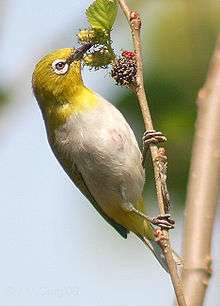
Order: Passeriformes Family: Zosteropidae
The white-eyes are small and mostly undistinguished, their plumage above being generally some dull colour like greenish-olive, but some species have a white or bright yellow throat, breast or lower parts, and several have buff flanks. As their name suggests, many species have a white ring around each eye. There are about 96 species worldwide and 2 species which occur in Oman.
- White-breasted white-eye, Zosterops abyssinicus
- Oriental white-eye, Zosterops palpebrosus
Old World orioles
Order: Passeriformes Family: Oriolidae
The Old World orioles are colourful passerine birds. They are not related to the New World orioles. There are about 30 species worldwide and 1 species which occurs in Oman.
- Eurasian golden oriole, Oriolus oriolus
Shrikes
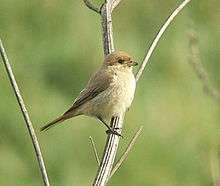
Order: Passeriformes Family: Laniidae
Shrikes are passerine birds known for their habit of catching other birds and small animals and impaling the uneaten portions of their bodies on thorns. A typical shrike's beak is hooked, like a bird of prey.
- Red-backed shrike, Lanius collurio
- Isabelline shrike, Lanius isabellinus
- Red-tailed shrike, Lanius phoenicuroides
- Bay-backed shrike, Lanius vittatus (A)
- Long-tailed shrike, Lanius schach (A)
- Southern grey shrike, Lanius meridionalis
- Steppe grey shrike, Lanius (meridionalis) pallidirostris
- Lesser grey shrike, Lanius minor
- Masked shrike, Lanius nubicus
- Woodchat shrike, Lanius senator
Bushshrikes and allies
Order: Passeriformes Family: Malaconotidae
Bushshrikes are similar in habits to shrikes, hunting insects and other small prey from a perch on a bush. Although similar in build to the shrikes, these tend to be either colourful species or largely black; some species are quite secretive. There are about 46 species worldwide and 1 species which occurs in Oman.
- Black-crowned tchagra, Tchagra senegala
Drongos
Order: Passeriformes Family: Dicruridae
The drongos are mostly black or dark grey in colour, sometimes with metallic tints. They have long forked tails, and some Asian species have elaborate tail decorations. They have short legs and sit very upright when perched, like a shrike. They flycatch or take prey from the ground. There are about 24 species worldwide and 1 species which occurs in Oman.
- Black drongo, Dicrurus macrocercus (A)
Crows, ravens and magpies
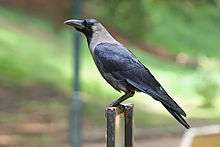
Order: Passeriformes Family: Corvidae
The family Corvidae includes crows, ravens, jays, choughs, magpies, treepies, nutcrackers and ground jays. Corvids are above average in size among the Passeriformes, and some of the larger species show high levels of intelligence. There are about 119 species worldwide and 4 species which occur in Oman.
- Eurasian magpie, Pica pica (A)
- House crow, Corvus splendens
- Brown-necked raven, Corvus ruficollis
- Fan-tailed raven, Corvus rhipidurus
Starlings
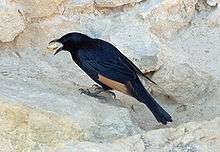
Order: Passeriformes Family: Sturnidae
Starlings are small to medium-sized passerine birds. Their flight is strong and direct and they are very gregarious. Their preferred habitat is fairly open country. They eat insects and fruit. Plumage is typically dark with a metallic sheen.
- Bank myna, Acridotheres ginginianus (I)
- Common myna, Acridotheres tristis (I)
- Brahminy starling, Sturnia pagodarum (A)
- Rosy starling, Pastor roseus
- European starling, Sturnus vulgaris
- Wattled starling, Creatophora cinerea
- Violet-backed starling, Cinnyricinclus leucogaster (A)
- Tristram's starling, Onychognathus tristramii
Weavers and allies
Order: Passeriformes Family: Ploceidae
The weavers are small passerine birds related to the finches. They are seed-eating birds with rounded conical bills. The males of many species are brightly coloured, usually in red or yellow and black, some species show variation in colour only in the breeding season. There are about 116 species worldwide and 1 species which occurs in Oman.
- Rueppell's weaver, Ploceus galbula
Waxbills and allies
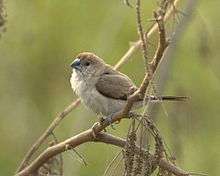
Order: Passeriformes Family: Estrildidae
The estrildid finches are small passerine birds of the Old World tropics and Australasia. They are gregarious and often colonial seed eaters with short thick but pointed bills. They are all similar in structure and habits, but have wide variation in plumage colours and patterns.
- African silverbill, Euodice cantans
- Indian silverbill, Euodice malabarica
- Scaly-breasted munia, Lonchura punctulata (I)
Finches
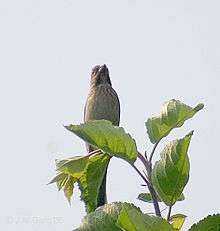
Order: Passeriformes Family: Fringillidae
Finches are seed-eating passerine birds, that are small to moderately large and have a strong beak, usually conical and in some species very large. All have twelve tail feathers and nine primaries. These birds have a bouncing flight with alternating bouts of flapping and gliding on closed wings, and most sing well.
- Brambling, Fringilla montifringilla
- Arabian golden-winged grosbeak, Rhynchostruthus percivali
- Common rosefinch, Carpodacus erythrinus
- Eurasian siskin, Spinus spinus (A)
- European goldfinch, Carduelis carduelis (A)
- Yemen serin, Crithagra menachensis
- Trumpeter finch, Bucanetes githaginea
Buntings
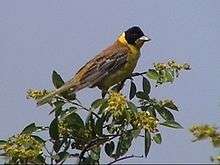
Order: Passeriformes Family: Emberizidae
The emberizids are a large family of passerine birds. They are seed-eating birds with distinctively shaped bills. In Europe, most species are called buntings. In North America, most of the species in this family are known as sparrows, but these birds are not closely related to the Old World sparrows which are in the family Passeridae. Many emberizid species have distinctive head patterns. There are about 329 species worldwide and 13 species which occur in Oman.
- Grey-necked bunting, Emberiza buchanani (A)
- Cinereous bunting, Emberiza cineracea (A)
- Ortolan bunting, Emberiza hortulana
- Cretzschmar's bunting, Emberiza caesia (A)
- House bunting, Emberiza striolata
- Cinnamon-breasted bunting, Emberiza tahapisi
- Little bunting, Emberiza pusilla (A)
- Rustic bunting, Emberiza rustica (A)
- Yellow-breasted bunting, Emberiza aureola
- Black-headed bunting, Emberiza melanocephala
- Red-headed bunting, Emberiza bruniceps (A)
- Reed bunting, Emberiza schoeniclus (A)
- Corn bunting, Emberiza calandra
Sparrows
_at_Bharatpur_I_IMG_5262.jpg)
Order: Passeriformes Family: Passeridae
Sparrows are small passerine birds. In general, sparrows tend to be small, plump, brown or grey birds with short tails and short powerful beaks. Sparrows are seed eaters, but they also consume small insects. There are 35 species worldwide and 4 species which occur in Oman.
- House sparrow, Passer domesticus
- Spanish sparrow, Passer hispaniolensis
- Chestnut-shouldered petronia, Petronia xanthocollis
- Pale rockfinch, Carpospiza brachydactyla
See also
References
- Blair, Mike; Porter, Richard; Preddy, Steve; Aspinall, Simon. "OSME regional list of birds". Ornithological Society of the Middle East. Archived from the original on 26 July 2008. Retrieved 10 September 2008.
- Clements, James F. (2007). The Clements Checklist of Birds of the World. Cornell University Press. ISBN 978-0-8014-4501-9.
- Eriksen, Hanne & Jens Eriksen (2008) "Additions and Corrections to the Oman Bird List, Edition 6". Retrieved 10 September 2008.
- Lepage, Denis. "Checklist of birds of Oman". Bird Checklists of the World. Avibase. Retrieved 10 September 2008.
- Sargeant, Dave E., Hanne Eriksen & Jens Eriksen (2008) Birdwatching guide to Oman, 2nd ed., Al Roya Publishing, Muscat. ISBN 978-9948-03-643-2